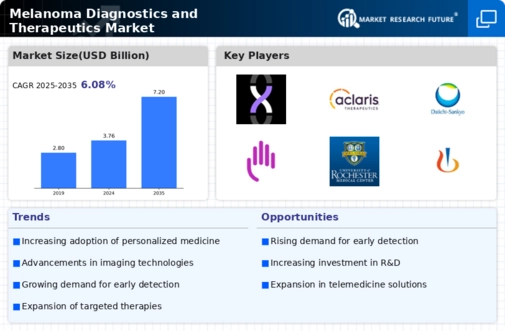Rising Incidence of Melanoma
The increasing incidence of melanoma is a primary driver for the Melanoma Diagnostics and Therapeutics Market. Data indicates that melanoma cases have been rising steadily, with an estimated annual increase of 3 to 5% in many regions. This trend necessitates enhanced diagnostic tools and therapeutic options to manage the growing patient population effectively. As awareness of skin cancer rises, more individuals seek early detection, further propelling the demand for advanced diagnostic technologies. The urgency to address this public health concern is likely to stimulate innovation and investment in the melanoma sector, thereby expanding the market. Consequently, stakeholders are focusing on developing novel therapies and diagnostic solutions to cater to the needs of an expanding patient demographic.
Advancements in Diagnostic Technologies
Technological innovations in diagnostic methodologies are significantly influencing the Melanoma Diagnostics and Therapeutics Market. The advent of non-invasive imaging techniques, such as dermoscopy and reflectance confocal microscopy, has revolutionized melanoma detection. These advancements allow for earlier and more accurate diagnosis, which is crucial given the aggressive nature of melanoma. Furthermore, the integration of artificial intelligence in diagnostic processes is enhancing the precision of melanoma identification. Market data suggests that the demand for these advanced diagnostic tools is expected to grow, as healthcare providers increasingly adopt technology-driven solutions. This trend not only improves patient outcomes but also drives market growth by attracting investments in research and development of cutting-edge diagnostic technologies.
Increased Focus on Personalized Medicine
The shift towards personalized medicine is significantly impacting the Melanoma Diagnostics and Therapeutics Market. Tailoring treatment plans based on individual genetic profiles and tumor characteristics is becoming increasingly feasible due to advancements in genomic testing. This approach not only enhances treatment efficacy but also minimizes adverse effects, leading to better patient compliance and satisfaction. Market data suggests that the demand for personalized therapies is on the rise, as healthcare providers recognize the benefits of customized treatment strategies. Consequently, pharmaceutical companies are investing in the development of targeted therapies that align with this trend, further propelling the growth of the melanoma market. The emphasis on personalized medicine is likely to reshape treatment paradigms and improve overall patient outcomes.
Regulatory Support for Innovative Therapies
Regulatory bodies are playing a pivotal role in shaping the Melanoma Diagnostics and Therapeutics Market by providing support for innovative therapies. Initiatives aimed at expediting the approval process for breakthrough treatments are becoming more prevalent. For instance, the designation of certain therapies as 'breakthrough' allows for faster access to the market, which is crucial for addressing unmet medical needs in melanoma treatment. This regulatory environment encourages pharmaceutical companies to invest in the development of novel therapies, knowing that they may receive quicker approval. As a result, the market is likely to see an influx of new treatment options that can significantly improve patient outcomes, thereby driving growth in the melanoma sector.
Growing Investment in Research and Development
Investment in research and development (R&D) is a critical driver for the Melanoma Diagnostics and Therapeutics Market. Pharmaceutical companies and research institutions are increasingly allocating resources to discover novel therapeutic agents and improve existing treatment modalities. The market has witnessed a surge in funding for clinical trials aimed at evaluating new drugs and combination therapies, which is essential for addressing the complexities of melanoma treatment. Data indicates that the global spending on oncology R&D has reached unprecedented levels, with melanoma-specific research receiving a substantial share. This influx of investment is likely to accelerate the development of innovative therapies, thereby enhancing the overall market landscape and providing patients with more effective treatment options.


















Leave a Comment